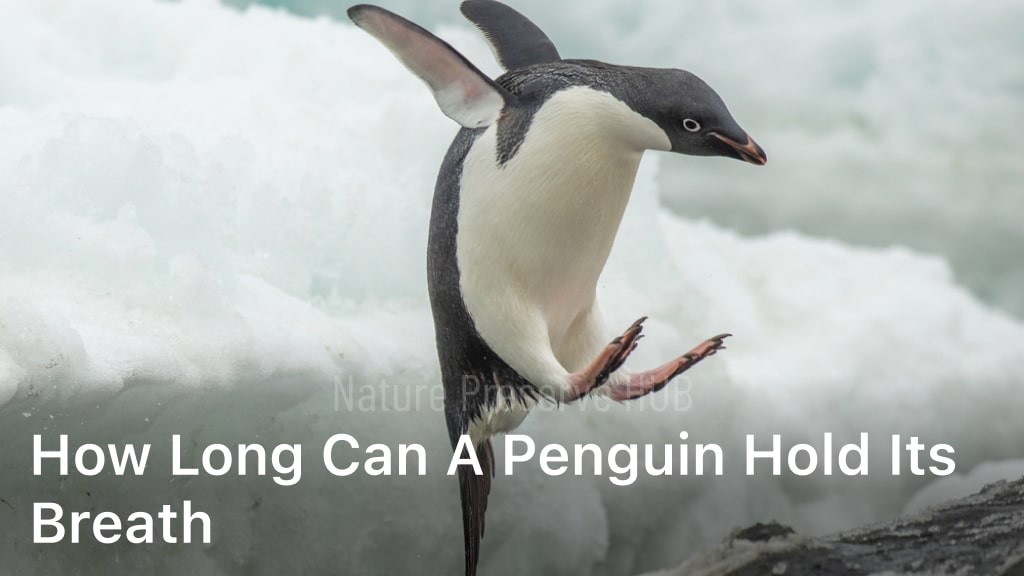How Long Can a Penguin Hold Its Breath?

naturepreservehub.com. How Long Can a Penguin Hold Its Breath – Dive into the world of penguins and discover fascinating facts, like how long can a penguin hold its breath. Unveil this aquatic secret now!
Have you ever wondered how long a penguin can hold its breath underwater? These fascinating creatures have adapted to their aquatic environment and developed impressive diving abilities.
How Long Can a Penguin Hold Its Breath
Penguins can hold their breath for an impressive amount of time underwater. Depending on the species, they can stay submerged for anywhere between 5 and 20 minutes.

In this section, we will explore the specifics of penguins’ ability to hold their breath, uncovering the adaptations that make them such skilled divers.
We will learn how they breathe while submerged, the factors that affect their breath-holding capacity, and compare their abilities to other animals known for their extraordinary underwater prowess.
Key Takeaways:
- Penguins are exceptional divers with impressive breath-holding abilities.
- Their physical adaptations enable them to navigate underwater with ease.
- Penguins breathe through specialized lungs and can conserve oxygen efficiently.
- Factors such as species, dive duration, and depth can affect their breath-holding capacity.
- Penguins hold remarkable records for dive durations and can stay underwater for extended periods.
The Adaptations of Penguins for Underwater Life
When it comes to aquatic animals, penguins are among the most adapted for underwater life. Their physical characteristics enable them to dive to great depths, navigate currents, and catch prey with ease. Let’s take a closer look at the adaptations that make penguins such exceptional divers.
Streamlined Bodies
Penguins have a streamlined body shape, which reduces drag and allows them to move efficiently through the water. Their wings are modified into flippers, which they use to “fly” underwater.
Specialized Lungs
The respiratory system of penguins is highly adapted for diving. They have a larger heart and more extensive blood vessels than other birds, which allow them to store more oxygen.
Additionally, their lungs are more massive and can collapse under pressure to prevent nitrogen from entering the bloodstream during deep dives.
Waterproof Feathers
Penguins have a thick layer of feathers that are tightly packed and coated with a waterproof oil. These feathers keep penguins warm and dry while diving, as well as helping them to move through the water with increased speed and agility.
Transparent Eyelids
One of the most unique adaptations of penguins is their transparent eyelids. These eyelids act as goggles, allowing penguins to see underwater while protecting their eyes from saltwater.
Webbed Feet
Penguins have webbed feet that act as paddles, enabling them to swim with great speed and agility. These webbed feet also allow them to change direction quickly and provide stability while diving.
Overall, penguins are incredibly well adapted to their underwater habitat. These adaptations have enabled them to become master divers, capable of staying submerged for long periods and hunting prey with remarkable efficiency.
Understanding Penguin Breathing Mechanism
Penguins are uniquely adapted to their aquatic environment. Their respiratory system has evolved to enable them to efficiently obtain oxygen while diving underwater. Let’s take a closer look at the breathing mechanism of penguins.
When penguins dive, they close their nostrils and rely on their lungs. The lungs are modified to store large amounts of oxygen, enabling them to hold their breath for long periods. Additionally, they have more extensive air sacs than other birds, allowing for efficient gas exchange.
While underwater, penguins decrease their heart rate and constrict blood vessels to conserve oxygen. The oxygen stored in their blood and muscles enables them to power through lengthy dives without needing to resurface for air.
The impressive breath-holding abilities of penguins are also due to the hemoglobin in their blood. Hemoglobin is a protein that binds to oxygen, which is then transported throughout the body. Unlike other mammals, penguins have a unique form of hemoglobin that is better suited to diving, with a higher oxygen affinity.
The respiratory system of penguins is a testament to the incredible adaptations that have helped them thrive in their aquatic environment.
By closing their nostrils and using specialized lungs and hemoglobin, they can hold their breath for remarkable durations and effectively hunt for food underwater.
Factors Affecting Penguin Breath-Holding Capacity
Various factors influence a penguin’s ability to hold its breath while diving. Understanding these factors helps to explain the variations in dive durations among different penguin species.
The Effect of Diving Depth
The deeper a penguin dives, the shorter the time it can hold its breath. This is because the increased pressure at greater depths compresses the penguin’s lungs, making it more difficult for the bird to inhale or exhale.
Therefore, deeper dives require penguins to surface more frequently to replenish their oxygen supply. For example, Adelie Penguins, known for their deep dives, can hold their breath for up to six minutes at a depth of 60 meters but only two minutes at 160 meters.
The Effect of Penguin Physiology
Each penguin species has unique physiological adaptations that allow them to dive and hold their breath for extended periods. The size of a penguin, proportional to its body mass and metabolic rate, is a significant factor in determining its dive duration.
Generally, larger penguins can hold their breath for longer periods than smaller ones. Emperor Penguins, the largest penguin species, can stay underwater for up to 22 minutes, while the Little Blue Penguin, the smallest, can only hold its breath for about 40 seconds.
The metabolism of a penguin also affects its breath-holding capacity. Penguins with lower metabolic rates can conserve oxygen longer, enabling them to hold their breath for extended periods. For instance, King Penguins, with a lower metabolic rate than other species, can remain submerged for up to six minutes.
The Effect of Penguin Dive Duration
Simply put, the longer the dive, the shorter the penguin can hold its breath. King Penguins, for example, can hold their breath for six minutes during dives that last 2-3 minutes. However, if they dive for an average of 10 minutes, their diving time reduces to a maximum of two minutes underwater.
The dive duration also affects the penguin’s energy consumption. Longer dives require more energy, and penguins must balance their dive duration with their food requirements.
Rockhopper Penguins, for example, spend less time underwater than other species because they feed on less energy-dense prey and need shorter dives to acquire enough food.
Records and Observations of Penguin Dive Durations
Penguins are known for their remarkable ability to stay submerged, enabling them to hunt for food and evade predators efficiently. The longest recorded dive by a penguin was achieved by an Emperor penguin, who stayed underwater for 32.2 minutes – a truly incredible feat.
Several other species of penguins have been observed staying underwater for over 20 minutes, including King, Gentoo, and Adelie penguins. These records showcase the impressive breath-holding abilities of these fascinating creatures.
| Penguin Species | Longest Recorded Dive Duration (minutes) |
|---|---|
| Emperor | 32.2 |
| King | 22 |
| Gentoo | 7 |
| Adelie | 23.6 |
These penguin dive records highlight the incredible adaptations these birds possess, enabling them to stay underwater for such extended periods. Their streamlined bodies and specialized respiratory and circulatory systems help them conserve oxygen and reduce their heart rate while submerged.
Observations of penguins in the wild have also provided valuable insights into their dive behavior. Researchers have found that dive duration varies based on several factors, including the species of penguin, diving depth, and physiological adaptations.
The data gathered from these observations and records have contributed to a better understanding of penguin behavior and their adaptations to their aquatic environment. It is a testament to the remarkable capabilities of these birds and their resilience in the face of challenging conditions.
Comparing Penguin Breath-Holding Abilities to Other Animals
While penguins may be known for their impressive breath-holding abilities, they are not the only animals capable of extended dives. In fact, many other species have developed unique adaptations to survive and thrive in aquatic environments. Let’s take a closer look at how penguins compare to some of their underwater counterparts.
Marine Mammals
When it comes to holding their breath, marine mammals such as whales, dolphins, and seals are some of the most impressive creatures on the planet.
The champion of breath-holding is the sperm whale, which can stay underwater for up to two hours. In comparison, the emperor penguin, the species with the longest recorded dive of all penguins, can hold its breath for just over 20 minutes. While penguins may not be able to match the impressive dive times of marine mammals, they are still remarkable divers in their own right.
Birds
Like penguins, many other bird species have evolved to be exceptional divers. One of the most notable examples is the common eider, a type of sea duck that can hold its breath for up to six minutes.
This is significantly longer than many penguin species, who typically hold their breath for around five minutes or less. However, unlike penguins, sea ducks have not adapted to swim underwater, instead using their wings to “fly” through the water.
Reptiles and Amphibians
While reptiles and amphibians are not typically associated with underwater diving, some species have developed the ability to hold their breath for extended periods.
For example, the leatherback sea turtle can hold its breath for up to 85 minutes while diving to depths of over 1000 meters. Frogs and other amphibians are also capable of impressive breath-holding, with some species able to survive for months without breathing by absorbing oxygen through their skin.
Conclusion
While penguins may not be the champions of breath-holding, they are truly remarkable animals that have evolved to thrive in their underwater habitat.
By comparing their abilities to other species, we gain a deeper understanding and appreciation for the diverse adaptations that have allowed life to flourish in aquatic environments.
Conclusion
Overall, penguins are remarkable creatures with impressive breath-holding abilities that enable them to thrive in their aquatic environment.
Their physical adaptations, including streamlined bodies, specialized lungs, and efficient oxygen utilization, allow them to navigate the depths with ease and dive for extended periods.
Factors such as dive duration, diving depth, and physiological differences between penguin species can all impact a penguin’s breath-holding capacity.
Nevertheless, observations and records of penguin dive durations have shown some extraordinary feats achieved by different species, with some penguins able to stay underwater for over 20 minutes.
While penguins are exceptional divers, they are not the only animals with impressive breath-holding abilities. Other marine mammals, such as dolphins and seals, as well as diving birds and turtles, can all stay underwater for extended periods, albeit for different reasons and with varying adaptations.
By understanding the unique abilities of penguins and other animals, we can gain a deeper appreciation for the remarkable adaptations that enable them to survive and thrive in their respective environments.
From their distinctive black and white plumage to their exceptional diving abilities, penguins are truly captivating creatures that continue to fascinate and intrigue researchers and animal lovers alike.
FAQ
What adaptations do penguins have for underwater life?
Penguins have several adaptations that enable them to thrive in their aquatic environment. These include streamlined bodies, webbed feet for efficient swimming, and dense feathers that provide insulation and waterproofing.
How do penguins breathe while submerged?
Penguins have a unique breathing mechanism that allows them to obtain oxygen while underwater. They can store oxygen in their muscles and blood, and their lungs extract a higher percentage of oxygen from each breath compared to other birds.
What factors affect a penguin’s breath-holding capacity?
Several factors influence a penguin’s ability to hold its breath. These include the species of penguin, dive duration, and the depth at which they swim. Different penguin species have varying breath-holding capabilities.
Are there any records of extraordinary penguin dive durations?
Yes, there have been remarkable observations and records of penguin dive durations. Some species, like the Emperor penguin, have been known to stay underwater for up to 20 minutes while hunting for food.
How do penguins compare to other animals in terms of breath-holding abilities?
Penguins are among the best breath-holding animals in the world. While they may not surpass mammals like whales and seals, penguins can outperform most other birds and display impressive underwater capabilities.





